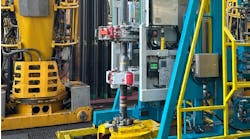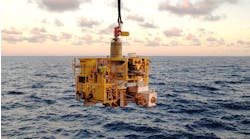Multi-mode riser shear tests could expand design options
Risers in deepwater and ultra-deepwater are often subject to vortex induced vibration (VIV), which can dramatically increase riser fatigue. VIV mitigation devices, such as strakes and fairings, are costly and have important design configuration and operational impacts. Undoubtedly, alternatives to standard practice would benefit the industry as production moves further offshore.
Current design practice demands the use of only the most conservative engineering tools, which could prove to be technically and economically infeasible in ultra-deepwater. Improved analysis tools could change present design requirements and in the process, could enable a more dynamic riser type with enormous potential savings.
The two main sources of hydrodynamic loading on marine structures are waves and vortex shedding. Vortices are subtle in that for many geometries and flow conditions, they are self organizing and lock into a structure’s natural frequency of vibration.
Owen Oakley, research consultant Chevron Energy Technology Co. and champion of a VIV research initiative for DeepStar, explains that VIV is of particular concern in deepwater.
“As offshore development moves into increasingly deeper water, riser design becomes ever more dependent on the ability to accurately predict VIV loads and their contribution to fatigue life,” Oakley says.
Drilling and production risers, flow lines, jumpers, pipelines, etc. are all subject to VIV and constitute a very high percentage of the capital cost of any field development. The result is a major design and operational challenge, both in terms of prevention and monitoring. VIV affects deepwater systems, subjecting them to fatigue and failure.
VIV research is important, Oakley says, because it will yield solutions that enable safe and reliable deepwater development.
“Drilling vessels in the deepwater GoM where there is a high-speed Loop Current cannot operate unless they can protect their risers,” Oakley explains. “We’ve found that just by putting fairings on risers has allowed Chevron and others to operate when drilling operations would otherwise be impossible.” The problem is critical. “If you don’t mitigate that, you’ll be shut down for a long time,” Oakley says.
Unfortunately, current predictive tools are either unproven or too conservative to allow confident evaluation or design optimization. The inexactness of today’s predictive tools has resulted in fatigue life predictions for deepwater risers that differ by orders of magnitude from one another, Oakley says.
Isolating the problem
VIV is a very difficult problem involving massive separation and highly turbulent flow. “While we have a complete mathematical descriptor in the Navier-Stokes equations, these can only be solved in their entirety at very low Reynolds numbers. Approximate methods are required to address real systems, i.e., model testing, empirical models and computational fluid dynamics (CFD),” Oakley says.
Model tests alone are insufficient, and laboratory scale tests cannot achieve the high mode numbers characteristic of long marine risers. Non-linear shear currents are especially difficult to model in the lab.
Design software, of necessity, involves extensive simplifications that must be benchmarked for accuracy and clarification of the degree of conservatism. With the recent increase in computer power, new analysis tools (CFD in particular) are emerging and are likely to significantly alter the way we do engineering design. Obviously, there is a critical need for accurate, high length-to-diameter VIV data in realistic shear currents for validating, benchmarking, and improving our design tools. A leveraged, joint industry project approach is clearly a cost-effective and efficient way to bring academic and industry experts together.
Objective and scope
The DeepStar program is tackling this challenge on a number of fronts, Oakley says. A unique and extensive set of laboratory tests was conducted at high Re in a Phase VI project within DeepStar. The results of the rigid cylinder experiments carried out in the Phase VI study will help to benchmark and upgrade empirical and CFD VIV models, Oakley says.
A Phase VII program that is now under way addresses the gap in high- and multi-mode VIV data in realistic shear current environments. DeepStar conducted tests using a long composite pipe with fiber-optic instrumentation. Deepstar also performed tow tests in the Gulf Stream, with and without strakes, in a wide range of current profiles. Data on both in-line and cross-flow modal response and damping are being extracted. And data from these shear tests as well as earlier uniform flow tests are being processed using advanced signal processing and system identification techniques, Oakley says.
The results will be used to benchmark empirical and CFD software and to improve software accuracy, which is critical for meeting the 10,000-ft water depth design challenges, Oakley says. Analysis and design guidelines are also being addressed.
Benefits of DeepStar
A number of benefits are expected to flow from the DeepStar VIV program. “Improved analysis tools are expected to allow VIV mitigation schemes to be optimized, which more than justifies the program,” Oakley says.
The ramifications of new tools are far reaching. “Enabling a more dynamic riser type could save tens of millions of dollars on a single deepwater project,” Oakley says. “Additional spin-offs in the area of riser instrumentation and system identification techniques should have broad application throughout the industry.”
Potential improvements in riser integrity monitoring methods and data interpretation are additional benefits expected from the program.
The success of offshore measurements in the Gulf Stream suggests that an extension of that program could prove highly beneficial. With that in mind, proposals for Phase VIII are under consideration, Oakley says, and can only move forward if funding for DeepStar Phase VIII is made available.
Owen Oakley earned a degree in naval architecture at the University of Michigan, did graduate work at MIT in ocean engineering and post-doctoral work at UC Berkeley. After teaching at MIT, Oakely moved to the offshore research group of Gulf Oil Corp. Oakley has been with the Chevron floating production team since 1995, working on deepwater issues. [email protected]
The DeepStar VIV program is an important component of the DeepStar Vessel, Mooring, and Riser (VMR) committee’s ultimate goal to enable safe, reliable, fit-for-purpose floating production systems in ultra-deepwater. The VMR committee has studied a wide range of topics, including full systems studies (spar, semisubmerisible, FPSO, etc.), conventional and innovative riser designs, polyester moorings, and vertically loaded anchors among others. In addition to enhancing the industry’s capability to predict VIV on risers, DeepStar is also leading development of global analysis and model testing guidelines for deepwater floating systems.
The DeepStar VMR committee has also provided a wide range of industry design guidelines for production risers, polyester moorings, and floating production systems.
Advancing these knowledge base technologies is critical for the successful application of deepwater riser and floating technologies.
DeepStar Phases
- Phase I 1992
- Phase II 1993 to mid-1994
- Phase IIA mid-1994 to 1995
- Phase III 1996 to 1997 Phase IV 1997 to 1999
- Phase V 2000 to 2001
- Phase VI 2002 to 2003
- Phase VII 2004 to 2005
System Engineering - Field Development Program
- 1992 Subsea system designs for 6,000-ft WD field development
- 1994 Establish first 6,000-ft WD basis of design for GOM fields
- 2001 Perform full life-cycle economic evaluation of 10,000-ft WD field development and technology needs
- 2003 Technology evaluation for deepwater satellite fields
- 2005 Technology evaluation for deepwater stand-alone fields
Subsea Tree Program
- 1994 Hydraulic and electric subsea coupler qualification
- 1994 Evaluation of horizontal trees
- 1995 Deepwater well intervention riser for 6,000-ft depth
- 1996 Intervention riser services from workboats
- 2001 10,000-ft tree and intervention gaps
- 2005 HP/HT subsea production
- 2005 Regulatory interface high integrity pressure protection system (HIPPS)
Deepwater Structures Program
- 1999 Comparative analysis of theme structures 3,000-10,000 ft WD
- 1999 Overview of VIV issues
- 2002 Ultra-deepwater classical spar design
- 2003 Global performance, verification of deepwater structures
- 2003 High Reynolds number test data & analysis
- 2004 10,000 ft WD spar Study
- 2005 10,000 ft WD semisubmersible design study
- 2005 10,000 ft WD TLP with composite tendon study
Flow Assurance Hydrate Program
- 1994 Flow assurance hydrate formation studies
- 1998 Hydrate plugging & low dosage inhibitor trials
- 2001 Chilled, multiphase single bare flowline technology
- 2002 Modeling hydrate formations and inhibitors for black oil
- 2003 Methanol partitioning into hydrocarbons
- 2004 Dry tree riser - fluid behavior during shutdown
- 2005 Develop a hydrate kinetics model coupled to OLGA
- 2006 Flowloop tests of cold flow






